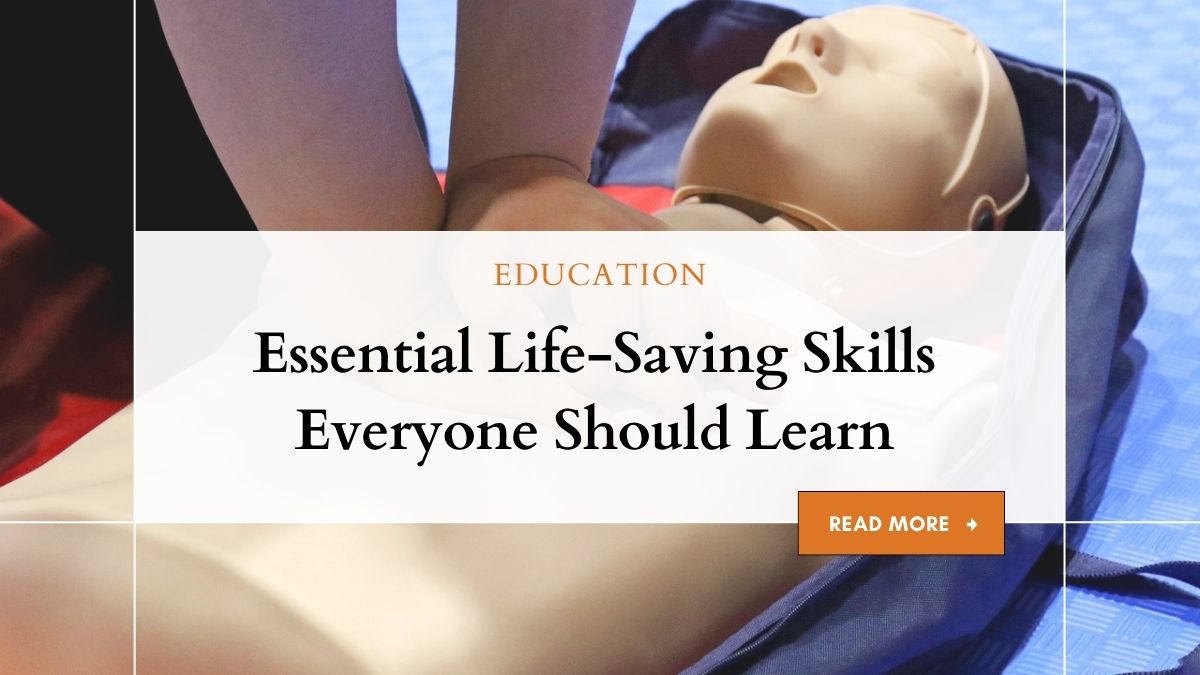
In this fast-paced and unpredictable world we live in, being equipped with life-saving skills is more crucial than ever.
Imagine finding yourself in a situation where a loved one, a stranger, or even your own life hangs in the balance, and you have the power to make a difference.
The truth is, emergencies can happen anytime, anywhere, and to anyone, and it is our responsibility to be prepared.
In this blog post, we will delve into a collection of essential life-saving skills that can empower you to become a real-life superhero.
Whether you’re a parent, a student, a professional, or simply a concerned citizen, these skills are invaluable assets that can save lives and create a safer world for everyone. Let’s get started.
Also, you can able to know,
CPR
CPR, or cardiopulmonary resuscitation, is a vital life-saving skill that everyone should learn.
CPR is a technique used to manually maintain blood circulation and oxygenation in a person whose heart has stopped beating.
It involves a combination of chest compressions and rescue breaths to keep the blood flowing and provide oxygen to the vital organs.
Learning these skills equips individuals to provide immediate assistance to someone experiencing a cardiac event, potentially saving their life. You can learn more about how to get these skills and also a certification for the same.
Understanding the proper techniques for CPR, recognizing the signs of cardiac arrest, and knowing how to use an automated external defibrillator (AED) are fundamental skills that empower individuals to take swift and effective action during critical situations.
Use of AED
The use of an AED (Automated External Defibrillator) is a critical skill that can significantly increase the chances of survival during cardiac emergencies.
An AED is a portable device that delivers an electric shock to the heart to restore a normal rhythm in cases of sudden cardiac arrest. Learning how to use an AED properly is essential in providing timely intervention.
By following simple step-by-step instructions provided by the device, individuals can quickly attach the AED pads to the patient’s chest, analyze the heart rhythm, and administer a shock if necessary.
Understanding the importance of AED placement, electrode positioning, and following the prompts can greatly enhance the effectiveness of resuscitation efforts, ultimately saving lives.
Controlling Bleeding
Controlling bleeding is a crucial life-saving skill that everyone should learn. Uncontrolled bleeding can lead to severe consequences and even death if not addressed promptly.
Whether it’s due to accidents, injuries, or emergencies, knowing how to control bleeding can make a significant difference.
The first step is to apply direct pressure to the wound using a clean cloth or sterile dressing. If the bleeding continues, applying additional pressure or using a tourniquet may be necessary.
Understanding the signs of severe bleeding, knowing how to assess the situation, and having the skills to apply appropriate techniques can help stabilize the injured person until professional medical assistance arrives.
Heimlich Maneuver
The Heimlich maneuver, also known as abdominal thrusts, is a vital life-saving skill that can be used to dislodge an object obstructing someone’s airway.
Choking is a common emergency that can quickly become life-threatening if not addressed promptly.
The Heimlich maneuver involves applying sudden upward pressure to the abdomen, just below the diaphragm, to create a strong cough reflex and expel the obstruction.
Learning this technique enables individuals to assist someone who is choking and unable to breathe.
Understanding the proper hand placement, performing the maneuver with sufficient force, and recognizing the signs of choking are crucial skills that can save lives in critical situations.
Escaping a Building on Fire
Escaping a building on fire is a crucial life-saving skill that everyone should learn to ensure their own safety and that of others.
In the event of a fire emergency, knowing how to navigate and evacuate a burning building can make a significant difference.
Firstly, it is essential to stay calm and assess the situation, identifying the closest and safest exit routes.
Crawling low to the ground to avoid smoke inhalation is crucial. Understanding the “Stop, Drop, and Roll” technique to extinguish any flames on oneself is vital.
Additionally, knowledge of alternative exit strategies, such as using windows or emergency escape routes, can be lifesaving.
Regular fire drills and familiarizing oneself with building layouts are important for effective fire escape planning.
Managing Burns
Managing burns is a critical life-saving skill that can minimize damage and alleviate pain in the event of a burn injury.
Burns can occur from various sources, including fire, hot surfaces, chemicals, or electricity. Prompt and proper management of burns is essential to prevent complications and promote healing.
The initial step is to remove the person from the source of the burn and cool the affected area with running cool water for at least 20 minutes.
Covering the burn with a sterile non-stick dressing helps protect it from infection. Understanding the different degrees of burns, recognizing signs of severe burns, and seeking medical assistance when necessary are crucial aspects of managing burns effectively.
Managing Insect and Snake Bites
Managing insect and snake bites is an essential life-saving skill that can help prevent complications and minimize the impact of these encounters with venomous creatures.
When encountering an insect or snake bite, the first step is to remove oneself from the immediate vicinity of the creature to avoid further harm.
For insect bites, washing the affected area with soap and water and applying a cold compress can help reduce swelling and itching.
Snake bites require immediate medical attention, and the affected person should remain as still as possible while waiting for help.
Avoiding the use of tourniquets or sucking out the venom is important to prevent additional harm.
Learning to identify venomous creatures in your area and knowing basic first aid measures for bites can be life-saving in the wilderness or outdoor settings.
Save from Drowning
Knowing how to save someone from drowning is a crucial life-saving skill that can make a significant difference in water-related emergencies.
Drowning is a leading cause of accidental death worldwide, and swift action is vital in rescuing a drowning individual.
The first step is to ensure personal safety by using a reaching object or extending a pole to reach the person in distress. If possible, throwing a floatation device or rope can also be effective.
If the person is within arm’s reach, the “Reach, Throw, Don’t Go” technique is advised to minimize the risk of both individuals drowning.
Immediately calling for help and performing CPR, if necessary, are additional steps that can potentially save a life.
Understanding the signs of drowning, staying calm, and having the knowledge and confidence to act swiftly are key elements in successfully rescuing someone from drowning.
Don’t miss: How to Become a Midwife Without a Nursing Degree
The bottom line
Acquiring essential life-saving skills is paramount for everyone. Skills like Cardiac Life Support (CLS), including CPR and the use of an AED, can significantly increase survival rates during cardiac emergencies.
Additionally, knowing how to control bleeding, perform the Heimlich maneuver, escape a building on fire, manage burns, and save someone from drowning are invaluable in critical situations.
By learning and practicing these skills, individuals can become empowered to respond effectively, potentially saving lives and making a positive impact in emergency situations.












